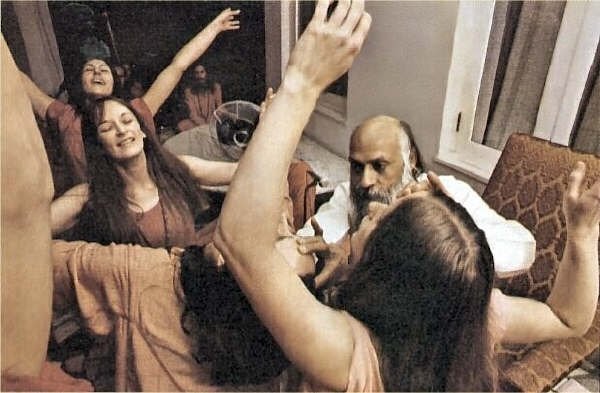OSHO
I THOUGHT THAT MEDITATION WAS A SIMPLE THING. BUT SEEING PEOPLE DOING VIPASSANA, I AM LOSING ALL HOPE OF EVER BECOMING A SUCCESSFUL MEDITATOR. PLEASE GIVE ME A LITTLE ENCOURAGEMENT.
MEDITATION is simple. PRECISELY because it is simple, it looks difficult. Your mind is accustomed to dealing with difficult problems, and it has completely forgotten how to respond to the simple things of life. The more simple a thing is, the more difficult it looks to the mind, because the mind is very efficient in solving difficult things. It has been trained to solve difficult things, it does not know how to tackle the simple. Meditation is simple, your mind is complex. It is not a problem that meditation is creating. The problem is coming from your mind, not from meditation.
Vipassana is the MOST simple meditation in the world. It is through vipassana that Buddha became enlightened, and it is through vipassana that many more people have become enlightened than through’ any other method. Vipassana is THE method. Yes, there are other methods also, but they have helped only very few people. Vipassana has helped thousands, and it is really very simple; is not like yoga.
Yoga is difficult, arduous, complex. You have to torture yourself in many ways: distort your body, contort your body, sit this way and that, torture, stand on your head — exercises and exercises… but yoga seems to be very appealing to people.
Vipassana is SO simple that you don’t take any note of it. In fact, coming across vipassana for the first time, one doubts whether it can be called a meditation at all. What is it? — no physical exercise, no breathing exercise; a very simple phenomenon: just watching your breath coming in, going out… finished, this is the method; sitting silently, watching your breath coming in, going out; not losing track, that’s all. Not that you have to change your breathing — it is not PRANAYAM; it is not a breathing exercise where you have to take deep breaths, exhale, inhale, no. Let the breathing be simple, as it is. You just have to bring one new quality to it: awareness.
The breath goes out, watch; the breath comes in, watch. You will become aware: the breath touching your nostrils at one point, you will become aware. You can concentrate there: the breath comes in, you feel the touch of the breath on the nostrils; then it goes out, you feel the touch again. Remain there at the tip of the nose. It is not that you have to concentrate at the tip of the nose; you have just to be alert, aware, watchful. It is not concentration. Don’t miss, just go on remembering. In the beginning you will miss again and again; then bring yourself back If it is difficult for you — for a few people it is difficult to watch it there — then they can watch the breath in the belly. When the breath goes in, the belly goes up; when the breath goes out, the belly goes in. You go on watching your belly. If you have a really good belly, it will help.
Have you watched? If you sec Indian statues of Buddha, those statues don’t have real bellies — in fact, no belly at all. Buddha looks a perfect athlete: chest coming out, belly in. But if you see a Japanese statue of Buddha you will be surprised: it does not look buddhalike at all — a big belly, so big that you cannot sec the chest at all, almost as if Buddha is pregnant, all belly. The reason why this change happened is that in India, while Buddha was alive, he himself was watching the breath at the nose, hence tr he he belly was not important at all. But as Vipassana moved from India to Tibet to China to Korea to Burma to Japan, slowly, slowly people became aware that it is easier to watch in the belly than at the nose. Then Buddha-statues started becoming different, with bigger bellies.
You can watch either at the belly or at the nose, whichever feels right for you or whichever feels easier for you. That it be easier is the point. And just watching the breath, miracles happen.
Meditation is not difficult. It is simple. Precisely because it is simple you are feeling the difficulty. You would like to do many things, and there is nothing to do; that is the problem. It is a GREAT problem, because we have been taught to do things. We ask what should be done, and meditation means a state of non-doing: you have not to do anything, you have to STOP doing. You have to be in a state of utter inaction. Even thinking is a kind of doing — drop that too. Feeling is a kind of doing — drop that too. Doing, thinking, feeling — all gone, you simply are. That is being. And being is meditation. It is very simple.
In your mother’s womb you were in the same space. In vipassana you will be entering again into the same space. And you will remember, you will have a DEJA-VU. When you enter into deep vipassana, you will be surprised that you KNOW it, you have known it before. You will recognize it immediately because for nine months in your mother’s womb you were in the same space, doing nothing, just being.
Never think about meditation in terms of success, because that is bringing your achieving mind into it, the egoistic mind into it. Then meditation becomes your egotrip. Don’t think in terms of success or failure. Those terms are not applicable in the world of meditation. Forget all about that. Those are mind terms; they are comparative. And that’s the problem: you must be watching others succeeding, reaching, ecstatic, and you will be feeling very low. You will be feeling silly, sitting and looking at your breath, watching your breath. You must be looking very silly and nothing is happening. Nothing is happening because you are expecting something to happen too much.
And in the beginning, every new process looks difficult. One has to learn the taste of it.
Just wait a little, Just a little patience. In the beginning everything looks difficult, even the simplest thing. And don’t be in a hurry.
That is one of the problems with the Western mind — hurry. People want everything immediately. They think in terms of instant coffee, instant meditation, instant enlightenment.
Just sitting for one day in vipassana, you will not come out of it smiling. You will come out utterly tired — tired because you were told not to do anything, tired because you have never been in such a silly thing ever before. Not doing anything? You are a doer! If you had chopped wood the whole day you would not have been so tired. But sitting silently, doing nothing, just watching your silly breath going in, coming out… many times the idea arises, “What am I doing here?” And the time will look very, very long, because time is relative. The time will become very long. One day’s meditation will look as if years and years have passed — “And what has happened? Is not the sun going to set today? When is it going to finish?”
If you are in a hurry, if you are in haste, you will never know the taste of meditation. The taste of meditation needs great patience, INFINITE patience. Meditation is simple, but you have become so complex that to relax it will take time. It is not the meditation that is taking time — let me remind you again — it is your complex mind. It has to be brought down to a rest, to a relaxed state. THAT takes time.
And don’t think in terms of success and failure. Enjoy! Don’t be too goal-oriented. Enjoy the sheer silence of watching your breath coming in, going out, and soon you will have a beauty, a new experience of beauty and beatitude. Soon you will see that one need not go anywhere to be blissful. One can sit silently, be alone, and be blissful. Nothing else is needed, just the pulsation of life is enough. If you can pulsate with it, it becomes a deep inner dance.
Meditation is a dance of your energy, and breath is the key.
OSHO
from : The Guest Ch. 15


